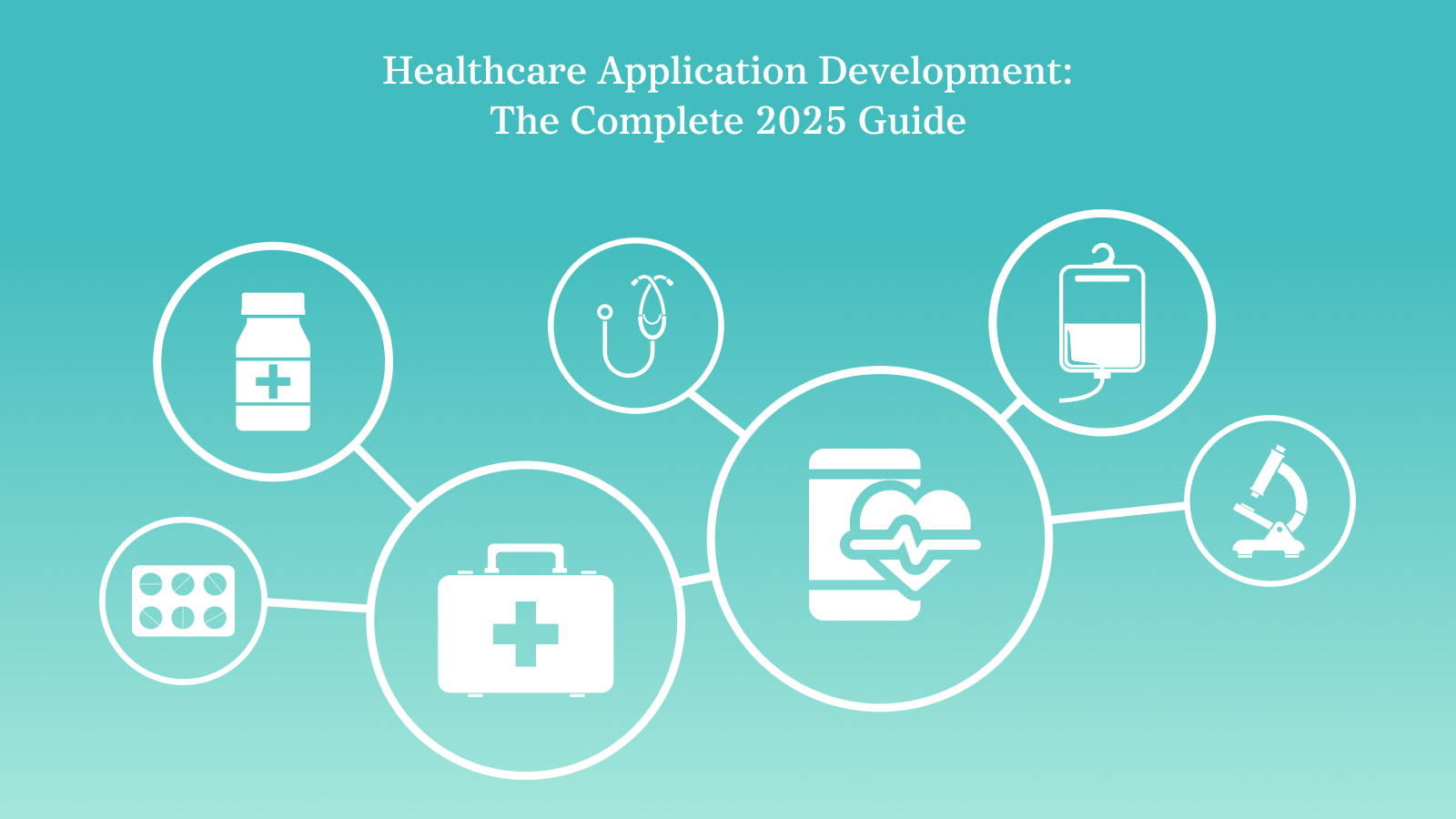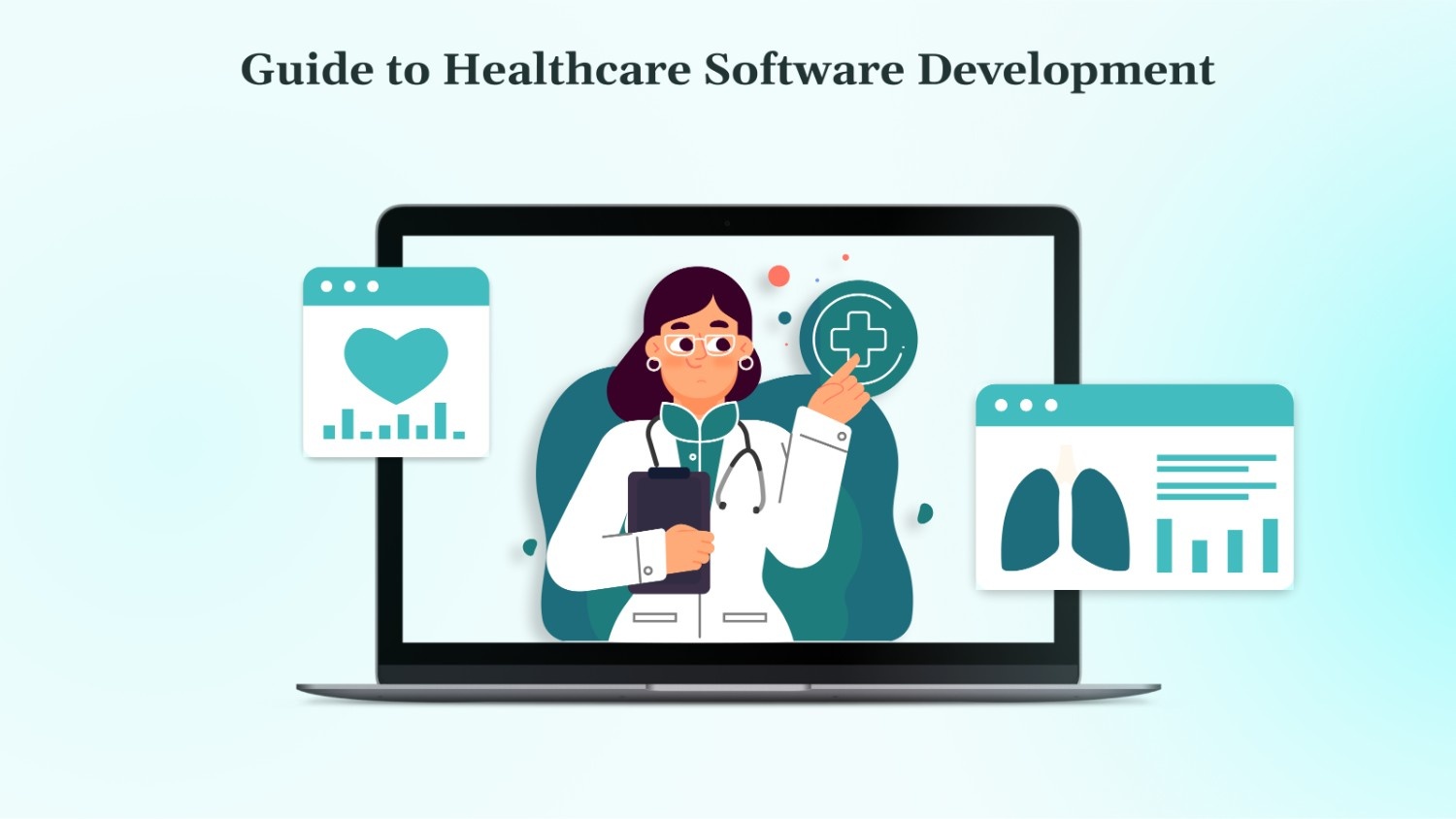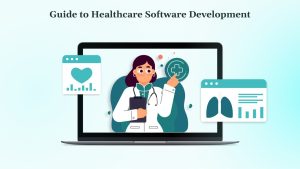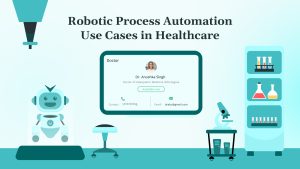IoT applications combine hardware, software, and connectivity to enable devices to collect data and interact with users or other systems. This convergence has transformed industries such as healthcare and agriculture by enabling automation and providing real-time insights.
In healthcare, the impact of IoT is instrumental. Today, 83% of U.S. hospitals use IoT devices to monitor patients and manage medical equipment, highlighting the technology’s role in healthcare application development.
This guide covers the process of creating an IoT app, focusing on architecture, security, compliance, and monetization. By addressing these elements, both business stakeholders and developers can successfully execute IoT solutions.
Key Takeaways
- Define Goals and Compliance Early: Start healthcare application development by clearly defining target use cases, user needs, and regulatory requirements like HIPAA to guide all subsequent stages.
- Prioritize Security and Privacy: Ensure patient data is protected through encryption, secure access controls, and adherence to industry regulations (HIPAA, GDPR). Build security into every layer of the app.
- Focus on User-Centric Design: A successful healthcare app must offer intuitive interfaces, real-time insights, and seamless integration with existing healthcare workflows (e.g., EHR systems) to drive user adoption.
- Choose the Right Technology Stack: Use secure, scalable technologies like Node.js, Python, and cloud platforms (AWS, Azure) for backend and mobile app development, ensuring both performance and security.
- Thorough Testing and Support: Rigorous QA testing, user feedback, and continuous monitoring are essential to ensure app reliability, security, and compliance, leading to a successful launch and long-term performance.
- Prepare for Future Innovations: Healthcare apps must stay ahead by incorporating AI diagnostics, wearable devices, AR/VR training, and blockchain for secure data exchange and personalized care, addressing both current and future healthcare needs.
Healthcare Application Development and Digital Health Adoption
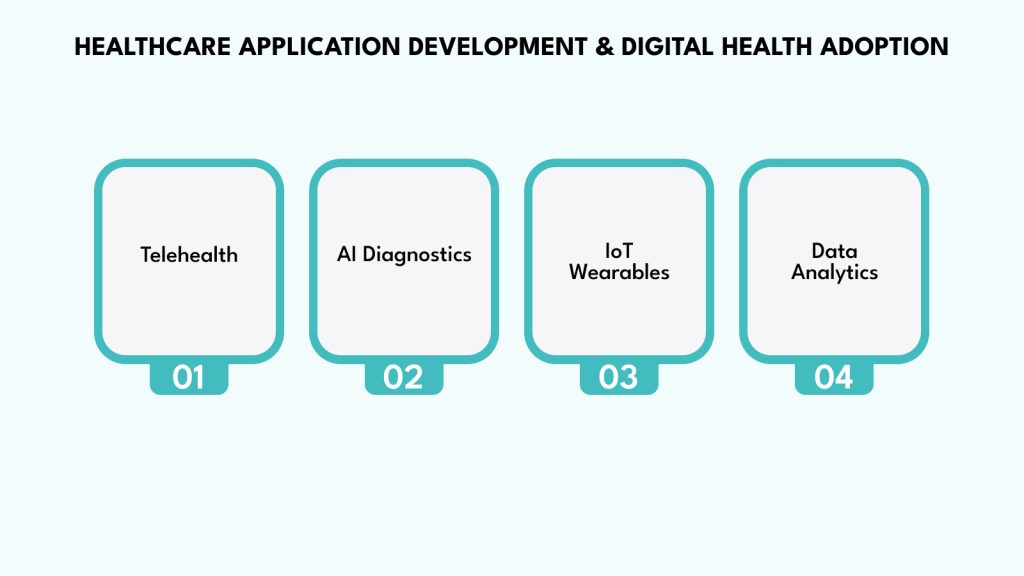
As of 2025, healthcare application development is witnessing a critical transformation. The integration of telehealth, AI diagnostics, IoT wearables, and data analytics is reshaping how healthcare is delivered and managed.
- Telehealth: Telemedicine platforms have experienced quick adoption, with providers utilizing remote consultations to reach patients in underserved or rural areas.
- AI Diagnostics: AI-driven tools are enhancing diagnostic accuracy, particularly in radiology, dermatology, and pathology, enabling quicker, more accurate detection of diseases.
- IoT Wearables: Wearable devices continuously monitor patient health metrics, such as heart rate, blood pressure, and glucose levels, enabling healthcare providers to offer proactive care and timely interventions.
- Data Analytics: Advanced data analytics empower healthcare providers to make informed, data-driven decisions, predict patient outcomes, and refine treatment plans based on real-time insights.
Patients today expect seamless access to healthcare services on demand, while healthcare providers are leveraging these digital tools to streamline operations, enhance clinical decision-making, and improve outcomes.
As digital health continues to gain momentum, several key trends are driving innovation in healthcare application development.
Key Trends Driving Innovation in Healthcare Application Development
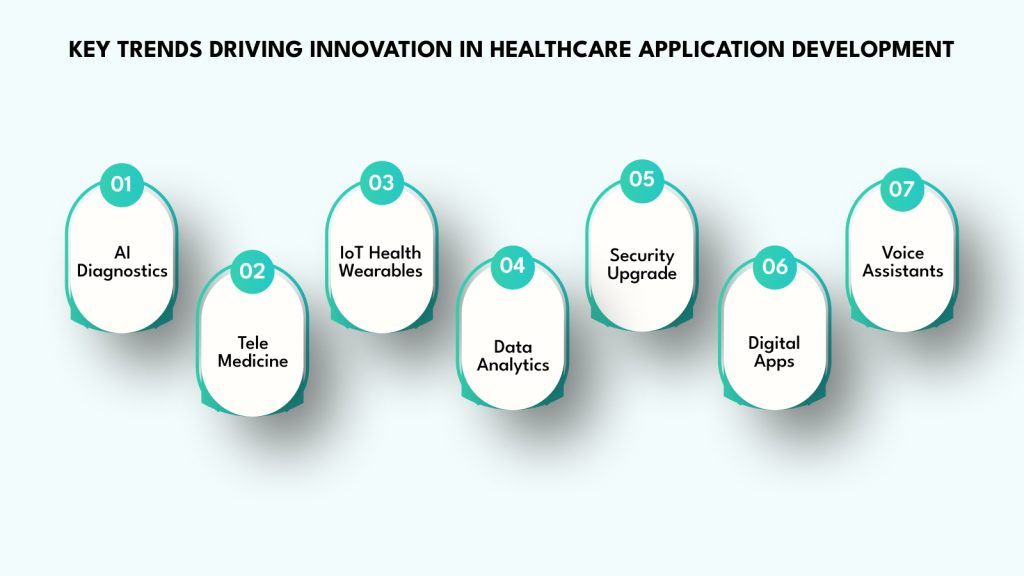
Healthcare application development is evolving, driven by technological advancements that enhance patient care and improve accessibility. The following trends are at the forefront of this transformation:
1. AI-Powered Diagnostics and Personalized Care
Artificial Intelligence (AI) is revolutionizing healthcare by enabling earlier detection of diseases and tailoring treatments to individual patients.
- AI in Diagnostics: AI algorithms analyze medical images, lab results, and patient symptoms to assist physicians in diagnosing diseases more quickly and accurately. For instance, AI-enhanced imaging improves the accuracy of MRI, CT scans, and X-rays.
- Personalized Treatment Plans: AI analyzes a patient’s health data, genetic information, lifestyle factors, and social determinants of health to generate highly customized care recommendations.
2. Telemedicine and Remote Patient Monitoring
Telemedicine platforms have become integral in providing remote consultations, diagnosis, and ongoing care, especially in underserved areas.
- Remote Consultations: Remote consultations improve healthcare access by eliminating geographical barriers, reducing travel time, and allowing patients to receive timely medical advice from the comfort of their homes. This approach is especially beneficial for individuals in rural areas, those with mobility issues, and during public health emergencies.
- Remote Patient Monitoring (RPM): Wearable devices and IoT technologies allow for monitoring of patients’ vital signs, facilitating proactive management of chronic conditions.
3. Integration of IoT Wearables in Healthcare
This connects medical devices and applications, enabling the collection and analysis of real-time data.
- Continuous Health Monitoring: Devices such as smartwatches and glucose monitors provide continuous streams of health data, enabling real-time monitoring and personalized interventions.
- Enhanced Patient Engagement: Integration with healthcare apps enables patients to track their health metrics, resulting in increased engagement and adherence to treatment plans.
4. Data Analytics and Interoperability
Advanced data analytics and interoperability standards are crucial for efficient healthcare delivery.
- Predictive Analytics: Analyzing large datasets helps predict disease outbreaks, patient admissions, and treatment outcomes, enabling better resource allocation.
- Interoperability Standards: Adoption of standards like HL7 and FHIR ensures seamless data exchange across electronic health records (EHRs), laboratories, pharmacies, and third-party services.
5. Enhanced Cybersecurity Measures
With the increasing digitization of healthcare, robust cybersecurity measures protect sensitive patient data.
- Data Protection: Implementing encryption, multi-factor authentication, and regular security audits to safeguard patient information.
- Compliance with Regulations: Adhering to standards such as HIPAA and GDPR to ensure data privacy and security.
6. Digital Therapeutics and Behavioral Health Apps
Digital therapeutics are evidence-based therapeutic interventions driven by high-quality software programs to prevent, manage, or treat a medical disorder or disease.
- Treatment for Chronic Conditions: Digital therapeutics are being developed for the prevention and management of diseases such as type 1 & type II diabetes, congestive heart failure, obesity, Alzheimer’s disease, and others.
- Behavioral Health Management: Apps focusing on mental health provide support for conditions like anxiety, depression, and stress, offering resources for coping strategies and therapy.
7. Voice Assistants and Conversational Interfaces
Voice-enabled and chatbot assistants are enhancing user experience in healthcare applications.
- Improved Accessibility: Voice commands enable patients, particularly the elderly and those with disabilities, to interact with healthcare apps more easily.
- Streamlined Administrative Tasks: Chatbots assist in scheduling appointments, answering queries, and providing reminders, reducing the workload on healthcare staff.
Now, let’s examine the tangible benefits, types, and impact these apps bring to both patients and providers.
Benefits and Impact of Healthcare Applications
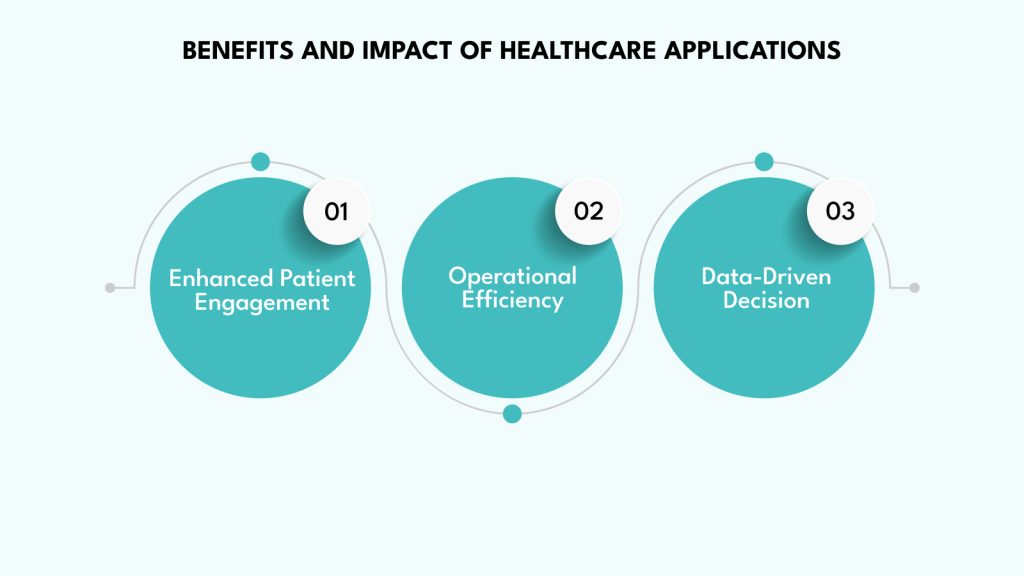
Healthcare applications are transforming both patient experiences and operational workflows in healthcare systems. Below are some of the key benefits and types of healthcare applications driving this change:
- Enhanced Patient Engagement and Outcomes: Healthcare apps enable patients to access their health data, utilize telemedicine services, and utilize self-management tools.
- Operational Efficiency for Providers: By automating scheduling, billing, and records management, healthcare apps reduce the administrative burden on providers, cut costs, and allow clinicians to focus more on patient care.
- Data-Driven Decision Making: Digital health applications gather and analyze patient data, enabling healthcare providers to make informed clinical and business decisions.
Types of Healthcare Applications
Healthcaremobile app development companies deliver a diverse range of applications:
| Type | Description | Examples |
| Patient-facing apps | Tools for individual health management and engagement | Telemedicine, remote monitoring, fitness trackers |
| Provider-facing systems | Clinical management, EHR/EMR solutions, and decision-support tools for healthcare staff | EHR platforms, clinical dashboards |
| Administrative & others | Hospital management, insurance, billing, and infrastructure software | HMS, insurance apps, claims processing |
Regulatory Requirements and Compliance Standards
Healthcare applications are subject to strict regulations to ensure the protection of sensitive patient data and to meet industry standards. Here is a breakdown of the key compliance requirements and security measures developers must integrate:
HIPAA Compliance (U.S.)
- Data Protection: Apps handling U.S. patient data must comply with the Health Insurance Portability and Accountability Act (HIPAA), which mandates data encryption, secure access controls, and regular security audits to ensure the privacy of Protected Health Information (PHI).
- Audit Trails & Access Control: Healthcare apps must log access and provide secure access controls to prevent unauthorized access to sensitive data.
- HIPAA-Compliant Cloud Solutions: Cloud platforms like AWS and Azure offer HIPAA-compliant storage and computing services, which developers can leverage to ensure compliance.
GDPR Compliance (EU)
- Explicit Consent: The General Data Protection Regulation (GDPR) requires healthcare apps collecting data from EU residents to obtain explicit consent from users before processing their data.
- Transparency & Access Control: Users must be able to easily access, modify, or delete their data. Healthcare apps require transparent privacy policies that outline how data is used and protected.
- Data Minimization: Collect only the minimum amount of data necessary for processing and ensure it is securely stored and managed.
FDA Guidance for Medical Software
- Regulatory Oversight: Certain healthcare apps may be classified as medical devices, such as those used for diagnostic purposes or patient health management. These apps must comply with FDA guidelines to ensure safety and efficacy.
- Risk Management: Apps that impact patient health must undergo a risk assessment and implement risk mitigation strategies. For example, apps used in drug dosage calculation must undergo rigorous clinical validation to prevent adverse effects on patients.
Security Standards
- End-to-End Encryption: Data must be encrypted both in transit and at rest. This prevents unauthorized access during data transmission and storage.
- Secure APIs: All third-party integrations must be secured using industry-standard encryption protocols, such as TLS and SSL, for data exchange.
Along with adhering to regulatory requirements, the right technology stack is imperative for building secure, scalable, and high-performance healthcare applications.
Technology Stack for Healthcare Application Development
Building secure, scalable, and future-proof healthcare applications, requires a solid techonology stack. Here is a detailed look at the technologies developers typically use:
Programming Languages & Frameworks
- Backend Development:
- Node.js: Ideal for high-performance, scalable applications, often used in real-time data processing.
- Python (Django): Popular for rapid prototyping and machine learning integration, especially in healthcare apps focused on data analysis.
- Java: A robust option for large-scale, enterprise-level healthcare applications, ensuring security and scalability.
- Mobile Development:
- Kotlin (for Android) and Swift (for iOS) are commonly used for building seamless mobile applications.
- React Native offers a cross-platform solution, reducing the need for separate codebases for iOS and Android.
Cloud Computing & Scalability
- Cloud Providers: AWS, Azure, and Google Cloud offer HIPAA-compliant, serverless architectures that can scale to meet demand. These platforms provide built-in security, compliance features, and data storage capabilities specifically designed for healthcare applications.
- Scalability: These cloud platforms enable healthcare apps to scale easily as user numbers grow or as more data is collected, ensuring that performance is maintained without compromising security.
AI & Machine Learning Integration
- Predictive Analytics: Machine learning models are increasingly used for analyzing patient data, predicting potential health risks, and supporting early intervention.
- AI Chatbots: These tools are used for triaging, providing symptom checkers, and offering personalized health advice based on user input.
- Deep Learning: Applied in medical imaging and diagnostics, deep learning algorithms enable healthcare providers to detect conditions such as cancer, retinal diseases, and heart disease earlier and with greater accuracy.
Once the right tech is in place, focusing on user-centric design and essential features ensures that the app is functional, accessible, and truly serves its users.
User-Centric Design and Essential Features of Healthcare Applications
The user experience is central to the success of healthcare applications. In 2025, developers are focusing on creating healthcare apps that are intuitive, accessible, and responsive across all platforms.
User-Centric Design
- Intuitive Interfaces: Simple, easy-to-navigate interfaces reduce cognitive load for both patients and clinicians, enabling users to access information or complete tasks quickly without confusion.
- Accessibility: Apps should cater to a broad audience, especially seniors or those with disabilities. This can be achieved by incorporating voice controls, larger text, and screen reader functionality.
- Mobile-First Design: Ensuring healthcare apps are responsive across various devices, smartphones, tablets, and desktops, ensures users can access healthcare services at any time, from anywhere.
Core Features of Healthcare Apps
- Secure User Authentication: Multi-factor authentication (MFA) and biometric logins (e.g., fingerprint or facial recognition) are essential for ensuring that only authorized individuals can access sensitive data.
- Appointment Scheduling & Reminders: Automated scheduling, calendar sync, and reminder systems ensure patients don’t miss appointments and stay on top of their healthcare routines.
- EHR/EMR Integration: Real-time access to health records is enabled through integration with Electronic Health Records (EHR), using HL7 or FHIR standards for data exchange between systems.
- Telemedicine Features: In-app video consultations, secure chat, and document sharing allow patients and healthcare providers to communicate effectively and securely.
- Payment & Insurance Integration: Built-in payment gateways, insurance verification, and claims processing simplify billing for both patients and healthcare providers.
Explore DEVtrust’s mobile app and Backend services for robust and secure feature implementation.
As healthcare apps handle sensitive data, ensuring robust security, privacy, and data integrity is crucial to maintaining trust and compliance.
Security, Privacy, and Data Integrity in Healthcare Applications
Security and privacy are non-negotiable when developing healthcare applications. Here’s how to ensure robust data protection:
Data Security Measures
- End-to-End Encryption: Ensure that patient data is encrypted at every stage, both in transit and when stored. Technologies like AES-256 encryption ensure that data cannot be accessed without the appropriate decryption key.
- Secure APIs: All integrations (e.g., with payment gateways and third-party services) should utilize secure, authenticated APIs to prevent potential breaches or unauthorized data access.
Continuous Monitoring and Compliance
- Regular Security Audits: Conduct frequent assessments and testing to identify and fix security gaps.
- Compliance with Standards: Ensure the app complies with relevant regulatory standards, including HIPAA, GDPR, and FDA guidelines. Failure to comply can result in severe penalties and loss of trust.
DEVtrust’s QA Testing and AI/ML teams ensure your app exceeds security and privacy standards.
With the proper security measures in place, interoperability and seamless integration across healthcare systems ensure smooth data exchange and more comprehensive care.
Interoperability and Integration with Health Systems
For healthcare applications to be practical, they must integrate seamlessly with other systems within the healthcare ecosystem. This ensures real-time data exchange and up-to-date patient information, which is critical for improving care and operational efficiency.
Seamless EHR Connectivity
Healthcare apps must connect with Electronic Health Records (EHR) systems to access and update patient information. This connectivity allows healthcare providers to have a comprehensive view of a patient’s health status, ensuring more accurate and timely treatment decisions.
- Challenge: Many EHR systems are proprietary, making integration difficult. Ensuring seamless data exchange is vital to prevent delays or errors in patient care.
Industry Standards (HL7/FHIR)
To facilitate smooth integration across various healthcare systems, developers rely on industry standards like HL7 and FHIR:
- HL7: A widely used standard that helps healthcare apps exchange administrative, clinical, and financial information securely.
- FHIR (Fast Healthcare Interoperability Resources): FHIR enables faster, real-time integration, ensuring that healthcare apps can connect with multiple data sources, such as laboratories, pharmacies, and wearable devices.
Integration Strategies: APIs and Middleware
Integrating different systems requires using APIs and middleware solutions:
- APIs: These allow your healthcare app to communicate with external systems like EHRs, labs, and pharmacies. For example, an app may utilize APIs to access lab test results in real time and update the patient’s medical record.
- Middleware: Acts as a bridge between different healthcare systems, ensuring secure data exchange and simplifying complex integrations.
DEVtrust’s Expertise:
At DEVtrust, we specialize in API integrations and creating scalable cloud architectures for healthcare apps. Our team leverages HL7, FHIR, and modern API technologies to ensure that your healthcare application can integrate seamlessly with EHRs, labs, pharmacies, and other services, all while maintaining security and compliance.
Integrating these systems efficiently is just one part, building an engaging, high-performance app is key to keeping users satisfied and ensuring high adoption rates.
Building an Engaging, High-Performance Healthcare App
Patient Engagement and Telehealth Features
Engaging healthcare apps focuses on making the user experience intuitive and accessible. By offering these features, you improve patient satisfaction, adherence to treatment, and overall health outcomes:
- Interactive Patient Portals: Personalized dashboards enable patients to view their records, message healthcare providers, and manage care with real-time updates, enhancing communication with healthcare providers.
- Education and Self-Management: In-app tutorials, reminders, and resources help patients understand their conditions and follow treatments, empowering them to manage their health effectively.
- Telehealth and Remote Monitoring: Video consultations, AI chatbots, and IoT device integration (e.g., glucose monitors) enable remote patient monitoring, reducing the need for in-person visits while maintaining care quality.
DEVtrust’s CMS and Frontend solutions empower you to build engaging, patient-centric digital experiences.
Testing and Quality Assurance
Rigorous quality assurance is vital for healthcare app development ios and cross-platform solutions:
- Automated Testing: Unit, integration, and regression tests catch issues early in the development lifecycle.
- User Testing and Feedback: Beta testing with real users, patients and clinicians, identifies usability gaps and pain points.
- Reliability and Performance: Load testing and real-time monitoring ensure smooth operation during peak usage.
DEVtrust’s QA Testing process ensures your healthcare app is reliable, secure, and compliant.
Deployment and Maintenance
A well-planned deployment strategy minimizes disruption and maximizes adoption:
- Phased Rollouts: Pilot programs in select clinics gather real-world feedback before a full-scale launch.
- Continuous Monitoring and Updates: Ongoing oversight, security patches, and regulatory compliance updates keep your app current.
- User Support and Feedback Loops: In-app support and help desks foster user satisfaction and drive continuous improvement.
DEVtrust offers end-to-end support, from deployment to ongoing maintenance, ensuring your investment delivers lasting value.
To bring all these elements together, selecting the right development partner is critical for creating a secure, scalable, and impactful healthcare app.
Choosing the Right Healthcare App Development Partner
Selecting the right development partner is crucial for the success of your healthcare app. Here’s what to look for:
- Domain Expertise: The partner must possess a comprehensive understanding of healthcare regulations, including HIPAA, GDPR, and FDA guidelines, to ensure compliance with these regulations.
- Technical Capabilities: Look for expertise in modern technology stacks, scalable cloud architecture, and the ability to integrate with healthcare systems.
- Proven Track Record: A partner with a track record in delivering secure, user-friendly healthcare apps is critical. Consider reviewing case studies to assess their success with similar projects.
DEVtrust specializes in custom healthcare app development, delivering secure, compliant, and scalable solutions for telemedicine providers, mental health startups, insurance tech companies, and more.
Explore our case studies to see how we deliver results for clinics, mental health startups, telemedicine providers, and insurance tech.
Future Directions and Innovations in Healthcare Application Development
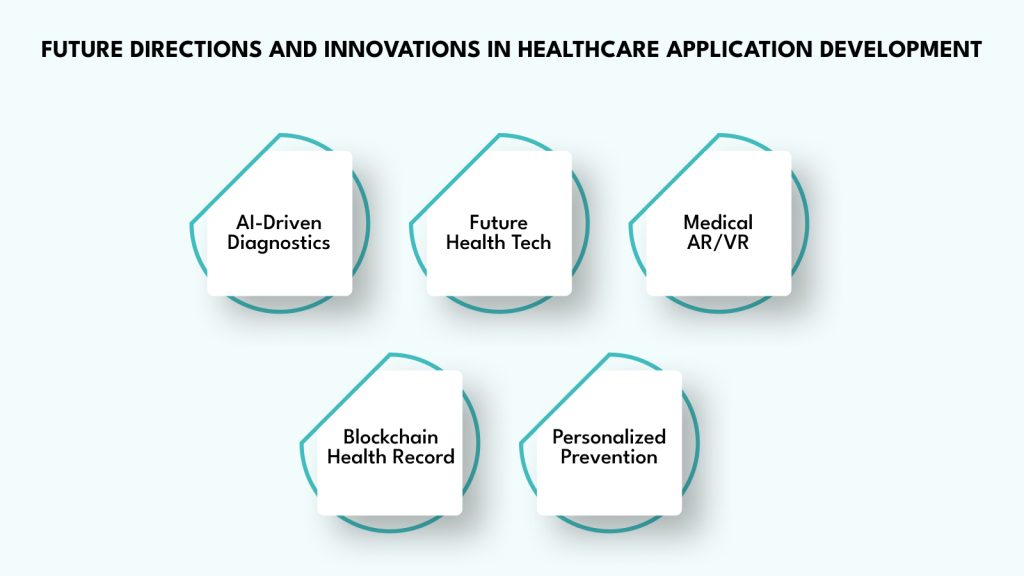
Healthcare app development is advancing rapidly, fueled by emerging technologies. These innovations are poised to transform the delivery of care, enhancing both patient outcomes and operational efficiency.
Below are some of the key advancements to watch out for in the coming years:
AI-Driven Diagnostics
AI is rapidly changing the way healthcare providers diagnose diseases. With advancements in machine learning and predictive analytics, AI will enhance diagnostic accuracy and improve treatment outcomes.
- Improved Diagnostic Accuracy: AI models are predicted to outperform general-practice doctors, achieving 85% diagnostic accuracy on complex cases
- Personalized Treatment Plans: AI will analyze patient data to deliver tailored treatment recommendations, enabling healthcare providers to make faster, more precise decisions.
Next-Generation Wearable Health Tech
Wearable health technology will evolve, providing real-time health monitoring and enabling proactive care. These devices will become essential tools for both patients and healthcare providers.
- Market Growth: The wearable medical device market is projected to reach $53.73 billion by 2025, growing at a CAGR of 25.90%.
- Increasing Adoption: Approximately 35% of U.S. adults currently use wearable health devices, with adoption rates expected to continue rising.
- Comprehensive Health Monitoring: Wearables will continuously track key metrics, including heart rate, glucose levels, and sleep patterns, allowing patients and providers to monitor their health in real-time.
AR/VR in Medical Training and Patient Engagement
Augmented Reality (AR) and Virtual Reality (VR) provide immersive, hands-on experiences.
- Medical Training: The AR and VR training market is expected to grow from $15.84 billion in 2024 to $405.49 billion by 2034, with a 38.3% CAGR.
- Improved Learning Outcomes: AR/VR training has been shown to increase learning effectiveness by 76% compared to traditional methods.
- Patient Engagement: VR will enhance patients’ understanding of medical procedures, reducing anxiety and improving recovery through immersive educational experiences.
Blockchain for Secure Health Records
Blockchain technology will provide a secure, decentralized system for storing health records, improving data security, and giving patients greater control over their personal health information.
- Patient Control: Blockchain will allow patients to access their health data and securely share it with healthcare providers.
- Data Interoperability: Blockchain will enable seamless and secure data exchange across systems, ensuring that patient records are always up-to-date.
Personalization and Preventive Healthcare
The future of healthcare will focus more on prevention and personalized care. Apps will leverage data to provide tailored health recommendations, helping patients take control of their health before issues arise.
- Market Potential: The personalized medicine market is expected to reach $2.4 trillion by 2025, driven by advancements in genomics, AI, and data analytics
- Smarter Health Recommendations: Apps will provide customized health insights, empowering patients to prevent disease and enhance their overall wellness.
- Proactive Disease Management: With more data at their fingertips, healthcare apps will focus on early detection and ongoing health monitoring to prevent severe conditions.
Conclusion
Creating a healthcare application demands more than technical expertise, it requires precision in architecture, security, and user experience from the outset. Every step, from defining objectives to managing integrations and compliance, directly impacts scalability, performance, and long-term success.
If your healthcare project calls for custom logic, real-time infrastructure, and seamless integration across platforms, DEVtrust brings the right blend of experience and execution. Our team builds robust, production-grade systems tailored to your goals. Connect with us to create healthcare solutions that work.
Healthcare Application Development: The Complete 2025 Guide
Boost your healthcare application development in 2025 with cutting-edge tech trends, robust security, and user-centric designs. Start building today!
Contact Us